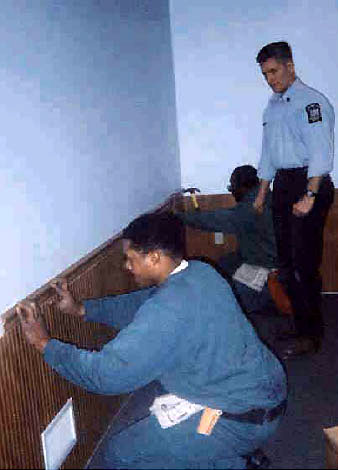OrleansBuilt on a sprawling tract of 45 acres of land adjacent to the Albion prison for females near the Erie Canal in Albion, Orleans was opened as a 542-bed medium-security facility for male inmates in December 1984. Prior to the opening, a staff of five civilian employees reported to work at Albion to be paid out of a payroll labeled “Albion II.” Eventually they set up shop in a large warehouse in nearby Medina where they ordered supplies and equipment, receipting the inventory and ensuring that the facility would be ready to receive its first scheduled draft of inmates. Of these original five employees, one, John Gurney, continues to work in the Maintenance Department. Orleans currently has about 480 employees, about 75 of whom have been there since the facility opened. Talk about stability over the decades ... Dedicated, professional employees are indeed the fuel that powers Orleans, a facility that has carved a unique and groundbreaking niche in the Department’s storied annals. In 1985, Sally Johnson was named to the top spot at this facility, which made her the first and only female Superintendent at a male prison in New York state at that time. She served admirably in that position for the ensuing 16 years, retiring three years ago. On October 24, 1985, in an effort to reach out to its new and curious neighbors, Ms. Johnson scheduled an open house for people from throughout the local community. Over 600 inquisitive visitors were given guided tours of the facility by security and civilian staff alike. They were afforded numerous question-and- answer sessions so they, too, could get to better know their new neighbors. And it’s been a mutually beneficial arrangement that continues to blossom on a daily basis.
Orleans was one of many so-called “cookie-cutter” facilities constructed by the Department in the 1980s to handle an almost overwhelming influx of inmates who were being sent to prison because of the crack epidemic that had not only gripped New York state but the entire nation. These prototype facilities went up quickly and thus let the Department meet its capacity needs in a timely fashion, translating to enhanced security for all. The original design was for 11 buildings with only one, the Administration Building, located outside the double-fenced secured perimeter. Over its 19-year history Orleans’ housing capacity has changed many times. Six months after its opening, plans for expanding the capacity of the facility by 200 beds were discussed and, due to the urgent need for more bed space, approved in short order. The expansion took place in 1986 with two more dormitory-style housing units being constructed. Each was capable of housing 100 inmates, bringing the capacity of the facility to 742. The following year, a housing unit was converted to a work release unit with the addition of 20 bunk beds. The general confinement dorms were increased to 54 beds each, bringing the capacity to 814. Due to an inmate housing shortage in 1989, 200 bunk beds were temporarily placed in the facility’s gymnasium and in gyms at several other medium-security facilities through the state. The gyms were large air-supported structures known throughout the system as “bubbles.” They were erected to provide for various indoor recreational activities. Those additional beds increased Orleans’ capacity to 1,014. In March of 1990, the inmates were moved out of the gym and into double-bunked, general confinement dorms. There were now 13 double-bunked dorms each with a 90-bed capacity and 30 double-bunked work release beds. That raised the capacity of the facility to 1,312. In 1991 double bunks were phased out over a six-month period with the exception of bunks in the work release unit, and the capacity dropped to 844.
That significant reduction in capacity was short lived. The facility was once again double bunked in December 1991 and the population returned to 1,312. The work release unit was converted back to a general confinement unit in June 1992 and the work release inmates were transferred to a nearby community-based work release facility, resulting in a net loss of 10 beds. The population remained relatively stable until April 1998. That’s when one of the nine “S-Blocks” went up on the grounds, increasing the capacity of the facility to 1,502. These 100-cell, double-bunked maximum-security units are designed to segregate from the general population those inmates in the region who chose to assault staff and others and disobey prison rules. The result has been much safer prisons throughout the state. Mirroring that trend, Orleans is indeed a much safer prison today than it was several years ago. Orleans has seen a 63 percent decline in the number of all unusual incidents since 1997, down from 132 to 42 last year. The number of inmate-on-staff assaults dropped by 67 percent between 1996 and 2002, falling from 12 to just three last year. There has never been an escape from within the secure perimeter. The population stabilized until the fall of 2000 when the Department began to “right-size” its population due to a population decline. It began vacating double bunks throughout the state. That enhanced security by not only lowering the number of inmates in each dorm, but also by improving Officer’s sight lines to monitor inmate activity. The current population of some 1,211 at Orleans is projected to decrease until it reaches its targeted capacity of 1,082. The complex has grown from the original 11 buildings to the current 33 buildings, 28 ofwhich are in the secure perimeter. Of the seven general confinement housing units, five are identical, one has cooking facilities (for the Honor Dorm inmates, which provides a valuable incentive for inmates not to act up) and one has had minor modifications to accommodate the physically disabled and wheelchairbound inmates. The most recent addition to the facility complex is a perimeter yard towerwhich was opened in March 2001.
Orleans was accredited in 1987 by the American Correctional Association, affirming that it meets nationally-acceptable standards in its management and operations. It was the ninth of the state’s 70 prisons to be accredited and has been accredited triennially since then. Orleans offers a full range of academic education, vocational training, alcohol and substance abuse treatment programming, counseling services and volunteer services programming. It also goes to great lengths to help ensure that inmates maintain strong family ties, a vital component when it comes to the success of an inmate upon their eventual reintegration into the community. In that regard, a Visitor’s Center designed to serve the families of inmates housed at Orleans and Albion was built and serviced its first visitors on October 3, 1987. It was the first of a new group of 12 such centers constructed by the Department at the time. The building was constructed by vocational inmates at Mid-Orange, transported to Orleans on a truck and placed on a concrete foundation. The center provides hospitality and a place to wait for those who are visiting inmates at Orleans or Albion. Many visitors have to travel hundreds of miles to get to western New York and at the end of their journey they need to “freshen up” and regroup before entering the facility for their visit. The center provides toast, coffee, cereal, fruit, baked goods and beverages to the visitors. Donations from the ILC and other inmate organizations pay for the food and beverages. Adressing room and rest rooms also are made available. At Orleans and elsewhere throughout the prison system, children are a primary focus of staff and community volunteers. An area with child-sized tables and chairs is designed for story reading, coloring and game playing. Many times just having a caring adult around to listen or interact with the children is what they need the most. Thus, the Child Enrichment Program (CEP) was taken one step further. The program began with community volunteers spending two hours each Saturday and Sunday with the children.
Today there is also continual coverage by specially screened and trained inmates. These inmates are required to attend a course in child development as well as attend workshops where they discuss how to apply the teaching and listening skill techniques that they have learned to actual circumstances. The center also provides educational material concerning health issues such as HIV/AIDS, drug and alcohol abuse, tuberculosis and hepatitis. Orleans also offers a variety of services to assist inmates through its well-crafted Transitional Services Program. Phase I of the comprehensive initiative is an orientation phase with incoming inmates placed in an initial two-week program. This phase gives the inmates an overview of the Department as well as a thorough, facility-specific orientation. They know from the start what will be expected of them and what types of behavior and other issues will not be tolerated. This is a mandatory program for all inmates. The concept behind Phase II is a program to provide inmates with the skills and tools that they will need to become productive, law-abiding citizens upon their eventual release from prison. Phase II is unique in that it combines many counseling techniques while fulfilling specific learning objectives in an academic setting.
Many hours went into the research and development of the materials necessary to craft Phase II. The end result is a 320-hour program supervised and taught by staff representing a wide range of disciplines; peer counselors also provide assistance as needed. The peer counselors are considered a vital cog in the ongoing success of the program in that they have a unique rapport with their fellow inmates. . . . . Among the vocational training offered to Orleans inmates are air conditioning and refrigeration, building maintenance, commercial arts, custodial maintenance, electrical trades, floor covering, general business, print shop, small engine repair and welding.
. . . .Volunteer Services is an integral part of the programming menu at Orleans. The volunteers compliment prison programs and offer a diversity of programs not provided by Orleans staff. There are approximately 25 programs which are overseen and run by about 185 community volunteers. The programs are set up to meet the needs of the majority of the inmate population and a number of the programs are religious in nature. They vary from Spanish Bible Study to “Fully Alive” and “Prison Fellowship.” Other programs, like AA and NA meetings, are sponsored through the Guidance Department with the help of volunteers from the community who relay their personal struggles and triumphs with the inmates. . . .
Every year the community volunteers are honored with an annual Volunteer Recognition Banquet. The highlight of the program is the awarding of the Superintendent’s Cup to the Volunteer of the Year. Just as dedicated community members are an important part of the operation at Orleans, staff at the facility have long been a vital and productive part of the local community. . . . Inmates are also an integral part of the local fabric via supervised community service crews. Program assignments include outdoor work assignments on behalf of local governments and non-profit groups. Projects include snow and debris removal, church repairs and fighting floods, ice storms and forest fires. Since 1995, Orleans crews have logged 121,100 work hours with more than 29,100 hours of security supervision. If not for DOCS, many of those projects would not otherwise be completed. Return to menu listing NYCHS excerpts of DOCS|TODAY Facility Profiles.
|








